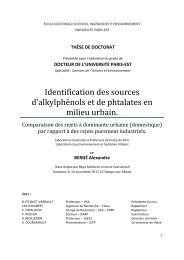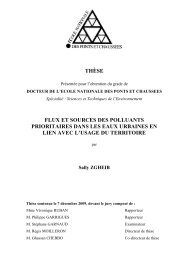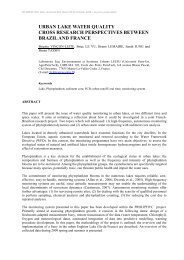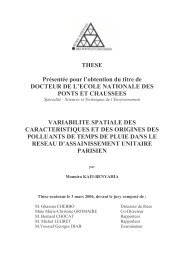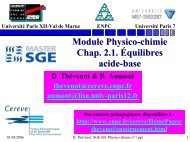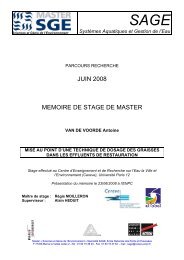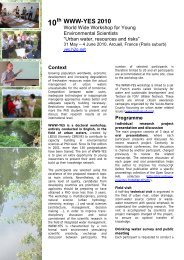INTRODUCTION6 Representation of a sustainable city: the exampleon practice of urban planning in the rivers andestuaries borders in the City of RecifeRebeca Vieira de Mello** PhD student, Université de Panthéon-Sorbonne (Paris 1), Laboratoire Ladyss(E-mail: rebeca.mello@gmail.com)AbstractIn the search for the sustainable city, the relation between protection of waters and theoccupation of its borders gain privileged space in the urban planning. However, speechand practice do not always walk together. In the city of Recife, Northeast of Brazil, thenew public lines on the use of the borders of the rivers is a good example of the danger ofthe vulgarization of the term of sustainable development. The project of eradication of theprecarious habitations on water considers the withdrawal of the families who inhabitwooden houses on stilts in these places and the restoration of the marginal zones. Thelocal authorities legitimize such project alleging to act by the means of sustainabledevelopment; moreover, the real environmental impact in the area is rarely taken intoconsideration. Although the eminent risk of flood, it is from the rivers and swamps thatthis population takes off its sustenance.KeywordsUrban water; resources, risk assessment, politics, sustainable developmentIt is not new to say, after stated at the United Nations conference meeting about the environmentof Rio de Janeiro 1992 (UNCED), that the implementation of a sustainable development in largecities has been introduced as one of the main commitments on their municipal managements.“The idea of sustainability recalls the logic of practice, where practical effects viewed asdesirable are made to happen. […] When applied to urban space, the idea of sustainability hasgenerated different representations and perspectives for managing cities” (Acselrad, 1999). Anexample of it in Recife is the incorporation of municipal Agendas 21, which holds as one of itsmain principle the line: "think globally, act locally" with leaflets and methodological guides thatassist the town planners to put sustainable development into practice.In spite of the fact that the rhetoric on those urban projects is in accordance with the speech ofthe urban sustainability - following the three dimensions: social, economic and theenvironmental – does it in practice, really represent a true change on the way of conceivingurban projects? Or may it only be some kind of "greenwashing", or even the vulgarisation of theterm in itself, turning it banal and meaningless?estuary, the borders of water were until then ignored and had little integration with the city’sactivities.In this search for the implementation of the sustainable city, urban rivers and wetlands begin tohave the meaning of natural patrimony to be preserved. “Water, it’s not only considers like anelement of the environment, but as an essential component of the ecosystems to be protected,restores and emphasize” (Gauthier, Lepage, 2005). By the simple adequacy of the waters’ flowwith urban necessities (rectification of banks, canalization of the streams, draining of theswampy zones, waterproofing of the borders), these projects try to integrate water and to respectits natural flow.This paper intends to analyze the representation of a sustainable development in the recent urbanplanning of the City of Recife and the vulgarization of the green speech. In this way, we willverify a example of occupation of borders on superficial waters.PROBLEMS AND CONTEXT:For a better understanding of the case of Recife, it is necessary to highlight some social andnatural characteristics of the place. Recife is situated in the tropical zone of Brazil, on the seacost, common estuary of three river basins. This forms a complex fluvial system composed byfive rivers and 66 canals. In low lands of the estuaries, there are the mangroves, that are swampyareas of transition between the river and the sea. The mangrove is a rich ecosystem, where wecan find you a great variety of clams, fishes, crabs and birds. It is an important area for theecosystem balance. Besides being a zone of reproduction of innumerable species, the zone isfundamental for the purification of the water and the absorption of rain waters, thus preventingfloods and cyclic inundations. However, the mangrove is threatened by the water pollution andthe constant embankment due to the urban growth towards the flooded zones.It is in these muddy areas of the rivers banks where the poorest population installs theirhabitation. The sprouting of slum in these places comes to the fact that these uncertain zonesbetween water and land do not possess commercial value. There are the last areas vacated by thecity center, where this population can find work. With the highest GIP (2,04 to euros/per capita)of a metropolitan region of approximately 3,5 million inhabitants, Recife exerts a strongdemographic attraction in the region. The flow of immigrants has two main origins: they runaway from drought of the arid countryside or they come from other cities near the littoral to trytheir luck in the capital. Arriving in Recife, the majority find themselves without work. Thusthey have no choice but improvise precarious shacks in the most devaluated areas. The slumshacks on the borders of the river are called palafitas, wooden houses on stilt.In the City of Recife, Northeast of Brazil, after the 90’s, urban projects have begun to integratethe perspective of a sustainable town development. Before it, urban planning was based on thepreservation of the cultural heritage. This idea of the conservation of the city heritage for futuregenerations was the first avatar on the urban sustainability. But, recently the city have begunintegrate the environment perspective. Recife is conquering the spaces along the waters as theborders, rivers and humid zones. Although they have been situated in the common rivers’WWW-YES 2008, Paris 13 – 16 May 2008 49WWW-YES 2008, Paris 13 – 16 May 2008 50
Geografia e Estatística (IBGE, Brazilian Institute of Geography and Statistics) estimates that88% of the domiciles are connected to the water supply net, but in the great majority of areas,water arrives to the taps each two days. Moreover, only 30% are connect to the used waterevacuation net. Only 20% of this volume is treated, and the rest of it is rejected in rivers andcanals without any treatment. The population perceives the river as an open air sewer that stinksand causes illnesses. Thus the city lives a paradox where the water is a major urban problem forits presence (polished state) or for its absence (potable state).Figure 3; 4: Palafitas in the rivers banks of Capibaribe image of: Renato SpencerMETHOD AND MATERIALFigure 4: Localization plan Figure 2: Recife, plan of river basinsThe conflict between social dynamics and the environment preservation is a major problem ofthe great Brazilian cities. This conflict has its origins in the relation between the urban growthand the social inequality. The substandard housing in the cities is a frequent alternative ofsettlement of the population with low purchase power. The social inequality is consequence ofthe disparity in the income distribution. Without access to the formal market of the urbanproperty, this part of the population occupies areas of environmental preservation, as fens andriver sides. This type of housing generates two different situations. The first one would be thelife risk that this part of the population is submitted, due to the fragility of the habitations againsthigh tides and the exposition to illnesses because of a very unsatisfactory sanitary condition. Thesecond deals with environment preservation, that generates the conflict between the individualright to occupy these spaces and the collective interest for preservation and protection of thisenvironment.The Town Hall estimates that more than 70 thousand people live on the rivers banks and canalsin Recife in precarious ways. Out of this total, 50,000 people live in palafitas, (JC, 2006). Thehouses of palafitas are spread in 32 areas along the rivers and the estuary. Without access to theservice of neither garbage collection nor water supply, the irregular habitations contribute for thewater pollution. The families who inhabit the borders of the rivers are at the same time cause ofthe degradation of the quality of waters and victims. They represent the part of the populationthat is more exposed to the illnesses of water propagation, as leptospirosis.Even if the town is surrounded by the water, the access to drinking water is becoming more andmore difficult, which proves the deficiency of its supplying system. The Instituto Brasileiro deThe method of research used understands the survey of the projects destined to the banks riverand flooded areas, the study of the urban evolution and the analysis of urban projects dealingwith the removal of the palafitas. From this survey, we could compare the official documentation(theoreticians) with the data observed in the local.The projects that aim to withdrawal the families living in substandard housings in flooded areasin Recife is not properly a new kind of intervention inspired by an holistic vision of thesustainable development. The first projects for the flooded areas in the town date from thebeginning of 20th century, motivated for the hygienists ideas. These projects consisted on thedestruction of the precarious shacks, fill the flooded zones with earth and in the relocation offamilies for houses in the periphery.In 2003, the city hall launches an ambitious project having as objective the eradication of thepalafitas in ten years, called "Recife sem palafitas" Recife without palafitas. Such project of thecity hall and the Ministry of the City acts in field of urban renewal of the flooded areas withpalafitas, with the objective to relocated and build proper houses to this population. The city hallpresents the project as being a set of urban, environmental, socio-economic and cultural actions.The project of the eradications of the palafitas is integrated to other central project office called“Capibaribe Melhor” A better Capibaribe River. This project counts on the support of the WorldBank. It’s a integrated actions of urbanism that aims to promote the environmentalrequalification of the Capibaribe river basin.Table 1: projectsWWW-YES 2008, Paris 13 – 16 May 2008 51WWW-YES 2008, Paris 13 – 16 May 2008 52



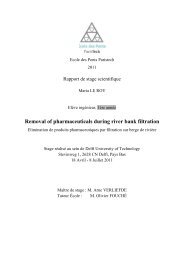
![[pastel-00730831, v1] Incidence des pratiques d'entretien ... - LEESU](https://img.yumpu.com/50938896/1/184x260/pastel-00730831-v1-incidence-des-pratiques-dentretien-leesu.jpg?quality=85)

